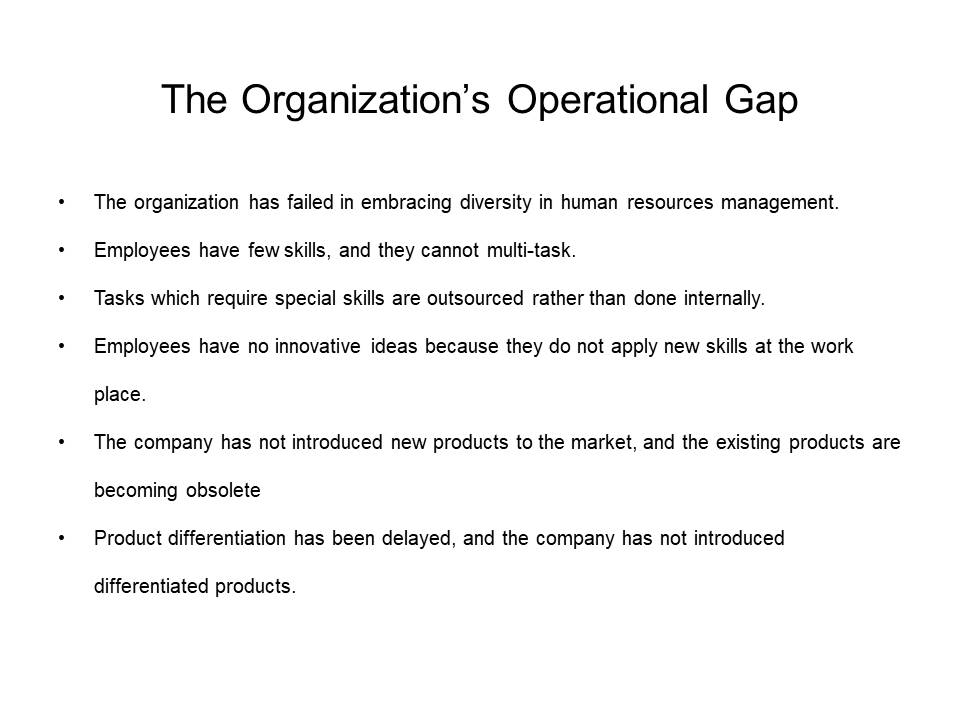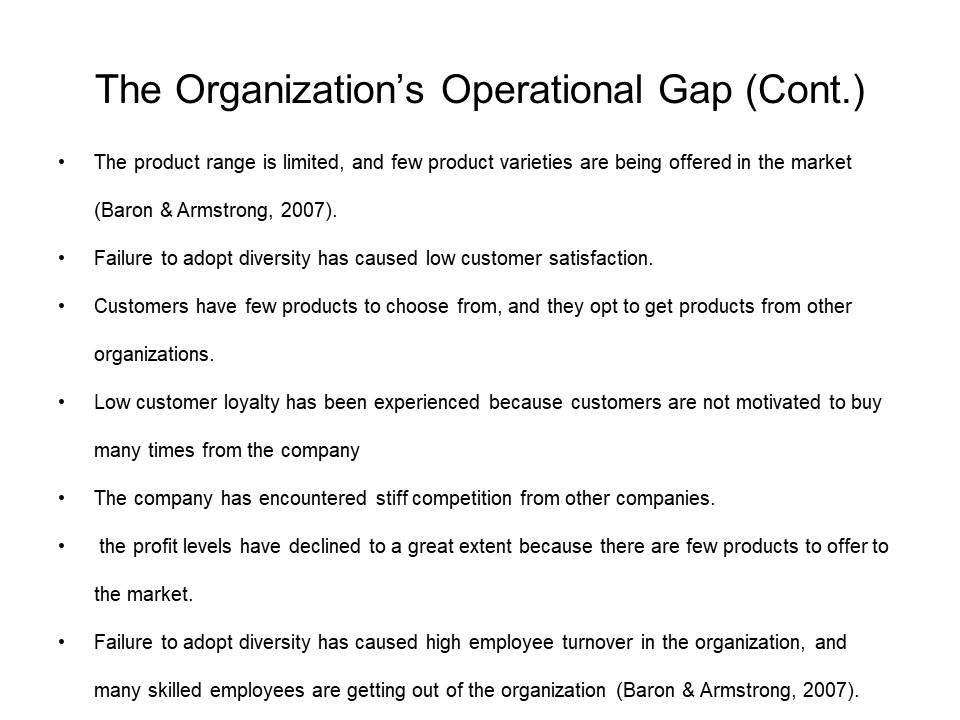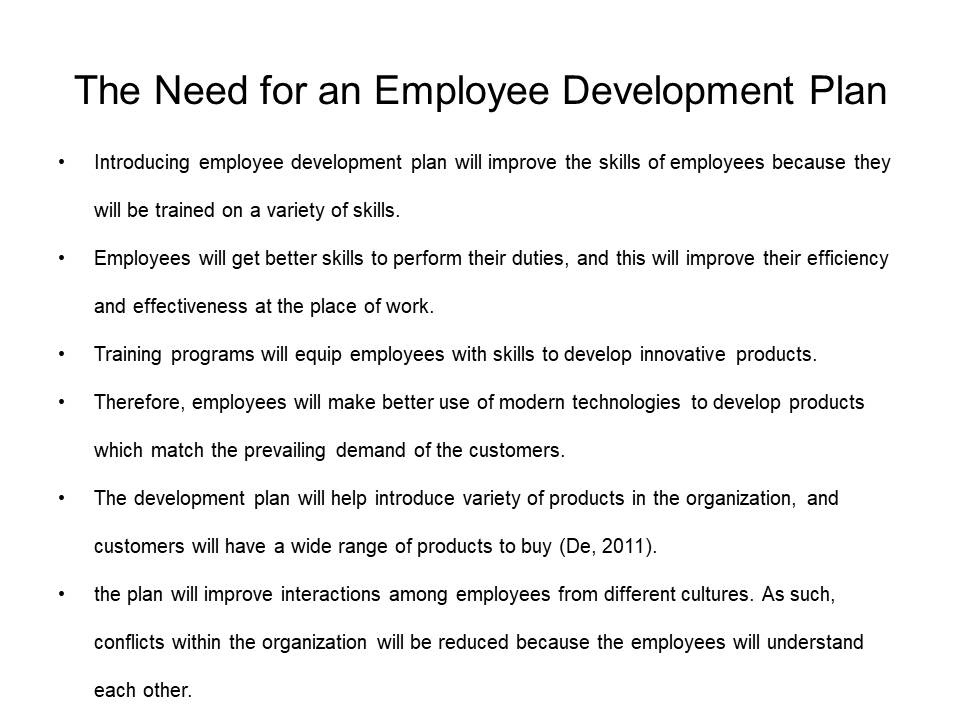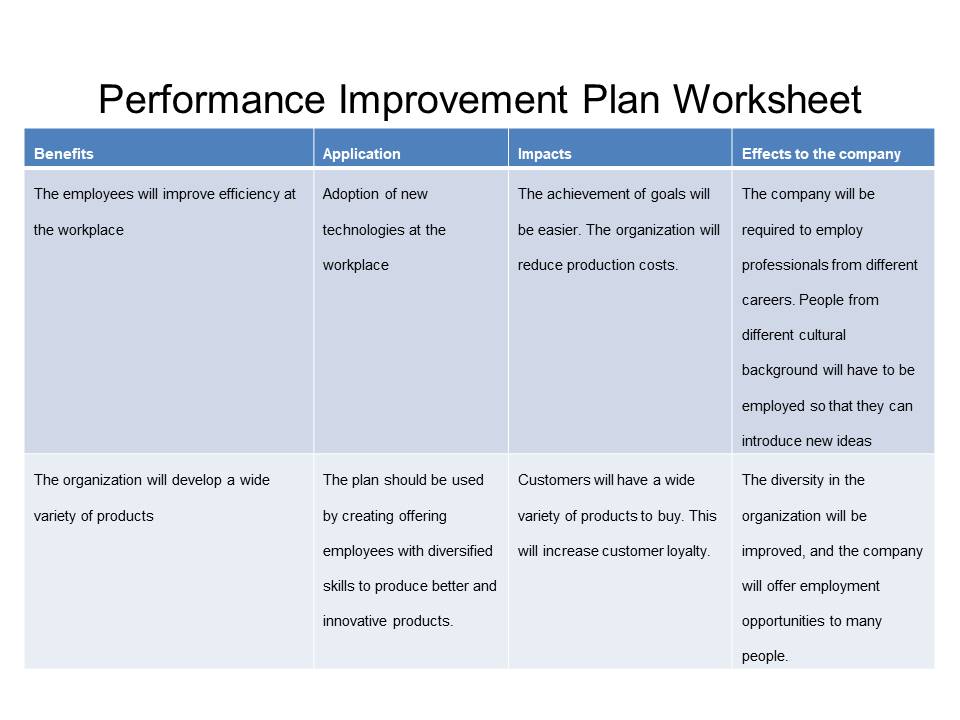The Organization’s Operational Gap
- The organization has failed in embracing diversity in human resources management.
- Employees have few skills, and they cannot multi-task.
- Tasks which require special skills are outsourced rather than done internally.
- Employees have no innovative ideas because they do not apply new skills at the work place.
- The company has not introduced new products to the market, and the existing products are becoming obsolete
- Product differentiation has been delayed, and the company has not introduced differentiated products.
- The product range is limited, and few product varieties are being offered in the market (Baron & Armstrong, 2007).
- Failure to adopt diversity has caused low customer satisfaction.
- Customers have few products to choose from, and they opt to get products from other organizations.
- Low customer loyalty has been experienced because customers are not motivated to buy many times from the company
- The company has encountered stiff competition from other companies.
- the profit levels have declined to a great extent because there are few products to offer to the market.
- Failure to adopt diversity has caused high employee turnover in the organization, and many skilled employees are getting out of the organization (Baron & Armstrong, 2007).
The organization has an operational gap in introducing diversity in the management of human resources. The employees have not diversified their skills, and this has made the organization fail in introducing variety of products. In addition, the organization has a low level of innovation. Product differentiation has also been minimal.
Failure to adopt diversification has caused low profit levels, poor customer satisfaction, low customer loyalty. In addition, stiff competition has been experienced in the industry.


The Need for an Employee Development Plan
- Introducing employee development plan will improve the skills of employees because they will be trained on a variety of skills.
- Employees will get better skills to perform their duties, and this will improve their efficiency and effectiveness at the place of work.
- Training programs will equip employees with skills to develop innovative products.
- Therefore, employees will make better use of modern technologies to develop products which match the prevailing demand of the customers.
- The development plan will help introduce variety of products in the organization, and customers will have a wide range of products to buy (De, 2011).
- the plan will improve interactions among employees from different cultures. As such, conflicts within the organization will be reduced because the employees will understand each other.
- The organization will comply with the government laws which require that companies have diversity.
- The provisions of the government require that all organizations should comply with the laws of equal opportunities to all people.
- The organization will get skilled employees as well as professionals from different careers.
- This will improve on the performance of the organization because employees will have the essential skills of developing better products.
- Therefore, the organization will attract and retain qualified professionals.
- The company will have the capacity to venture into the international market because it will easily learn the needs of people from different cultures.
- Introducing the training plan will help the organization improve its competitiveness in the market.
- This will result from the increased demand for the products from the customers.
- As a result, the company will increase the profits made from the sales of the products.
- Therefore, employee development plan will increase efficiency of employees. Hence improve quality and quantity of products offered to the market.
- Efficiency in the production process will reduce the cost of production in the organization (Macarena & Gonzalo, 2010).
There is need for the organization to develop a plan to improve skills of the employees. This will improve their performance, and equip them with necessary information about developing innovative products.
The employee development plan will improve on the competitiveness of organization’s products. This will increase demand for the products, and the company will make more profits. In addition, the efficiency of employees will be improved, and the quality of products will improve and costs of production will reduce.



Outline of the Proposed Employee Development Plan
- Employees should be trained after they are recruited at the workplace. This will acquaint them to the processes of the organization.
- After the first training, continuous training programs should be practiced to ensure that employees have up-to-date information and knowledge.
- The continuous training programs can be done once in a year.
- The training programs should not interfere with the activities of the company.
- Therefore, the training programs should be compatible with the work schedule of the organization (Earnest & Shawnta, 2003).
- Adequate research will be conducted to identify the technologies in the market.
- This will help develop training programs which match the prevailing technologies in the market.
- The employees will be involved in the decision making process to determine the best strategies to adopt in implementing the appropriate training hand development programs
- This will improve inclusiveness in the organization.
- In addition, employees will readily accept decisions made by the organization concerning their training and development programs (De, 2011).
The proposed development plan will entail the training of employees after recruitment, and the continuous training of employees to improve their skills. The training programs can be done once in a year, and they should not adversely affect the performance of employees.
Conducting research will help identify appropriate technologies to develop innovative products. Employees should be involved in decision making process. This will help employees accept all the decisions made by the top management.


Performance Improvement Plan Worksheet

References
Baron, A., & Armstrong, M. (2007). Human capital management: Achieving added value through people. London: Kogan Page Ltd.
De, B. S. (2011). Managing cultural diversity. Maidenhead ; Graz [u.a.: Meyer & Meyer.
Earnest, F. & Shawnta S. F. (2003). “Managing diversity using a strategic planned change approach”, Journal of Management Development, 22(10), pp.863 – 880.
Macarena L, & Gonzalo S. (2010). “Managing the effects of diversity on social capital”, Equality, Diversity and Inclusion: An International Journal, 29(5), pp.491 – 516.